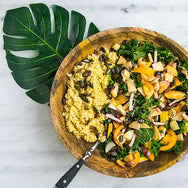
By Linia Patel
Gluten intolerance on the rise – is it real or a fad?
It’s all the rage right now; in fact, you might even be thinking of going gluten-free yourself. Is gluten sensitivity really on the rise or is this just another fad? What are the benefits of going gluten free? Let's take a closer look.
What is gluten and gluten intolerance?
Gluten is a protein found in wheat, barley, rye, spelt and oats (to a lesser extent). Originally, gluten-free diets were designed to combat celiac disease. Celiac disease is an autoimmune disorder characterized by a permanent intolerance to gluten. When people who have celiac disease consume gluten, their immune system responds by damaging the finger-like villi in the small intestine, preventing them from absorbing vital nutrients such as iron, folate, calcium and vitamin D. Gluten intolerance/sensitivity, on the other hand, is a term used to describe individuals who can’t tolerate gluten but who don’t have celiac disease. After eating gluten-containing foods, people with gluten sensitivity generally experience symptoms (such as gas, bloating and lethargy) but very mild or no intestinal damage.
"Are people actually gluten intolerant or are they suffering from other gut issues?"
Prevalence in the UK
Celiac affects about 1 percent of the population (about 630,000 people). Data from Allergy UK suggests that around 5-6% of the UK population have digestive-related problems relating to sensitivity towards gluten. Yet, more people than ever are buying, cooking and eating gluten-free foods -- not that they all require the diet. According to a recent poll, 60% of adults have bought a gluten-free product and 10% of households contain someone who believes gluten is bad for them. Over the last year, the annual growth for the demand for gluten free produces was reported to be around 25%.
Why the increase?
There are many hypotheses about the sudden increase in interest in the gluten-free way of life, as well as the rise of patients raising gluten-related concerns. Firstly, we are eating more wheat than ever before. Tried having lunch lately without wheat? It’s actually quite a challenge. And to add to that, the wheat today is very different from the wheat our ancestors ate. The proportion of gluten protein and amylase trypsin inhibitors (ATI’s) in wheat has increased enormously as a result of hybridization (changes to crops to make them more drought resistant or to ensure that they bake more easily and attractively). However, our guts may not have adapted to these changes. Secondly, unlike coeliac disease and wheat allergy where there are definitive tests and biomarkers to confirm diagnosis, for gluten sensitivity there is no definitive diagnosis. As a result, there has been an explosive growth in people “self-diagnosing” as suffering from gluten intolerance. What’s more, the signs of gluten sensitivity vary widely and can overlap with other health conditions such as lactose intolerance or irritable bowel syndrome. So are people actually gluten intolerance or are they actually suffering from other gut issues? Let’s also not forget that in recent years gluten-free has also become a weight loss fad promoted by celebrities like Gwyneth Paltrow and Miley Cyrus.

Living gluten free
Despite the lack of clarity around gluten sensitivity, gluten-free eating appears here to stay, whether it's trendy for some or necessary for others. In the meantime, here are some things you need to know before you decide to go gluten free:- If you think you have celiac, you must talk to your doctor first. Before taking treatment (i.e. gluten-free eating) into your own hands, you want to be sure you get a proper diagnosis. If you're losing weight, deficient in iron, anemic or you have a family history of celiac disease, talk to a doctor before simply giving up gluten to see how you feel.
- Involve a registered dietitian/ nutritionist. Although gluten has not nutritional value in itself, making a radical change to one’s diet without the supervision of a dietitian/ nutrition expert is not a smart move. You may end up eliminating key elements of the diet like vitamins and fibre for example. It’s also important to remember that symptom severity and the amount of gluten tolerated vary from person to person. A dietitian/ nutrition expert will be able to work through a robust elimination diet and will also be able to help you ascertain your level of tolerance.
- You don’t have to give up all grains. Not all grains have gluten. You’ve got lots of options, including quinoa, buckwheat, amaranth, millet and rice.
- Gluten is often hidden in many places. You’ll want to get good at reading labels and gluten is very often found in places you wouldn’t expect like supplements, salad dressings or veggie burgers.
- You won’t necessarily lose weight. It all depends how you go gluten-free. Ditching refined carbs in favour of wholegrains and less processed foods will automatically cut excess carbs and fill you up with quality nutrients. However, if you replace gluten-containing products with gluten-free counterparts – you’re likely to start consuming more sugar and fat (and therefore calories). It’s also important to remember that as your intestinal track recovers (if you really are gluten intolerant) and begins to absorb nutrients properly there is a chance that you may even gain some weight.
Linia's a leading dietitian and sports nutritionist, passionate about empowering people to better manage their health and optimise their performance through learning the essence of healthy eating. Visit her website here.





























































